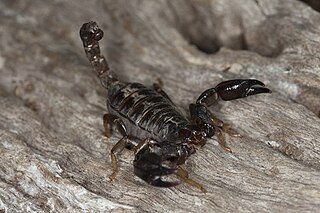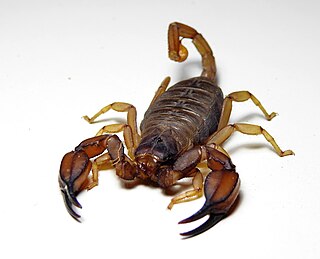
Scorpions are predatory arachnids of the order Scorpiones. They have eight legs, and are easily recognized by a pair of grasping pincers and a narrow, segmented tail, often carried in a characteristic forward curve over the back and always ending with a stinger. The evolutionary history of scorpions goes back 435 million years. They mainly live in deserts but have adapted to a wide range of environmental conditions, and can be found on all continents except Antarctica. There are over 2,500 described species, with 22 extant (living) families recognized to date. Their taxonomy is being revised to account for 21st-century genomic studies.

Reginald Innes Pocock F.R.S. was a British zoologist.

Nepidae is a family of exclusively aquatic Heteropteran insects in the order Hemiptera. They are commonly called water scorpions for their superficial resemblance to scorpions, due to their raptorial forelegs and the presence of a long slender process at the posterior end of the abdomen, resembling a tail. There are 14 genera in the family, in two subfamilies, Nepinae and Ranatrinae. Members of the genus Ranatra, the most widespread and species-rich genus, are sometimes called needle bugs or water stick insects as they are slenderer than Nepa.

The big crested mastiff bat, is a bat species from South and Central America.

The Sudell's frog, painted burrowing frog, trilling frog or desert trilling frog is a species of burrowing frog common to a large part of southeastern Australia. It is found on and west of the Great Dividing Range of New South Wales to western Victoria and southern Queensland as well as far eastern South Australia.

The desert long-eared bat is a species of vesper bat found in North Africa and the Middle East.
The Finke River hardyhead is a species of fish in the family Atherinidae. It is endemic to the Finke River system in the Northern Territory, where it is widespread in open water or around aquatic vegetation. They occur in a wide range of salinity and pH and in Summer seek refuge in semi-permanent water holes. They are omnivores and feed on small crustaceans, insects, gastropods, polychaete worms, algae and fish eggs. This species shows a wide tolerance to temperature and salinity and is omnivore, probably spawning during warmer months. It was previously mis-identified as Craterocephalus eyresii.
Dryotribus mimeticus is a species of beetle in the family Curculionidae. It is endemic to the United States, with the species also being recorded on Scorpion Reef a remote island chain in Mexico. The species also occurred in Florida, it has been suggested in Biologia Centrali-Americana that it was actually introduced to Hawaii from the Florida population. The species was said to have occurred in drift logs on Laysan Island, French Frigate Shoals, Johnston Island and Wake Island. Despite being considered extinct since 1986, 2 specimen of D. mimeticus were found and collected in the Dominican Republic in 1997; 11 years after the species was said to be extinct. In 2002 another specimen of the species was collected in Montserrat.
The taxonomy of scorpions deals with the classification of this predatory arthropod into 13 extant families and about 1,400 described species and subspecies. In addition, 111 described taxa of extinct scorpions are known.

The Scorpionidae make up the superfamily Scorpionoidea. The family was established by Pierre André Latreille, 1802.

Urodacus is a genus of scorpion belonging to the family Urodacidae. It was described by German naturalist Wilhelm Peters in 1861. The type species is U. novaehollandiae. Its species are native to Australia, and dig burrows. The genus was placed in its own family in 2000. Before this, the group had been a subfamily Urodacinae within the family Scorpionidae.

Urodacus manicatus, commonly known as the black rock scorpion, is a species of scorpion belonging to the family Urodacidae. It is native to eastern Australia.

Urodacus yaschenkoi, also known as the inland scorpion or the desert scorpion, is a species of scorpion belonging to the family Urodacidae. It is native to central Australia. It is also referred as the desert robust scorpion, because of its robust black colour and a long tail lined with a deadly hook.

Urodacus elongatus, commonly known as the Flinders Range scorpion, is a species of scorpion belonging to the family Urodacidae. They are endemic to the Flinders Ranges of South Australia. They were described by L.E. Koch in 1977.

Hormurus karschii is a species of scorpion belonging to the family Hormuridae.
Cyperus centralis is a sedge of the family Cyperaceae that is native to arid areas of central Australia.

Urodacidae is a family containing two genera of scorpions, both of which are endemic to Australia. It was first described by British zoologist Reginald Innes Pocock in 1893. Formerly a subfamily (Urodacinae) of the Scorpionidae, it was later raised to family rank.
Urodacus armatus, also known as the yellow sand scorpion or inland desert scorpion, is a species of scorpion in the Urodacidae family. It is native to Australia. It was first described in 1888 by British zoologist Reginald Innes Pocock.











